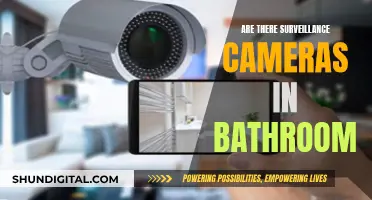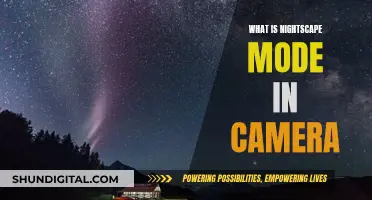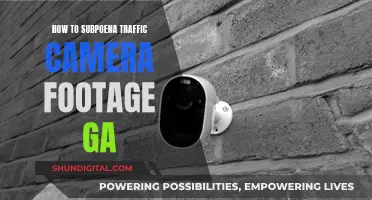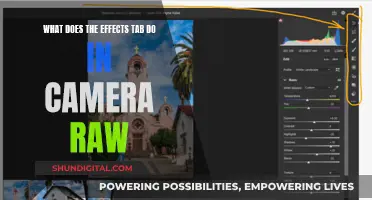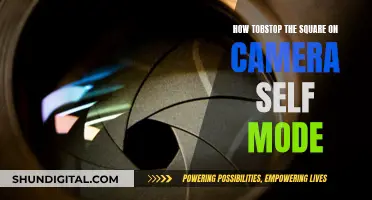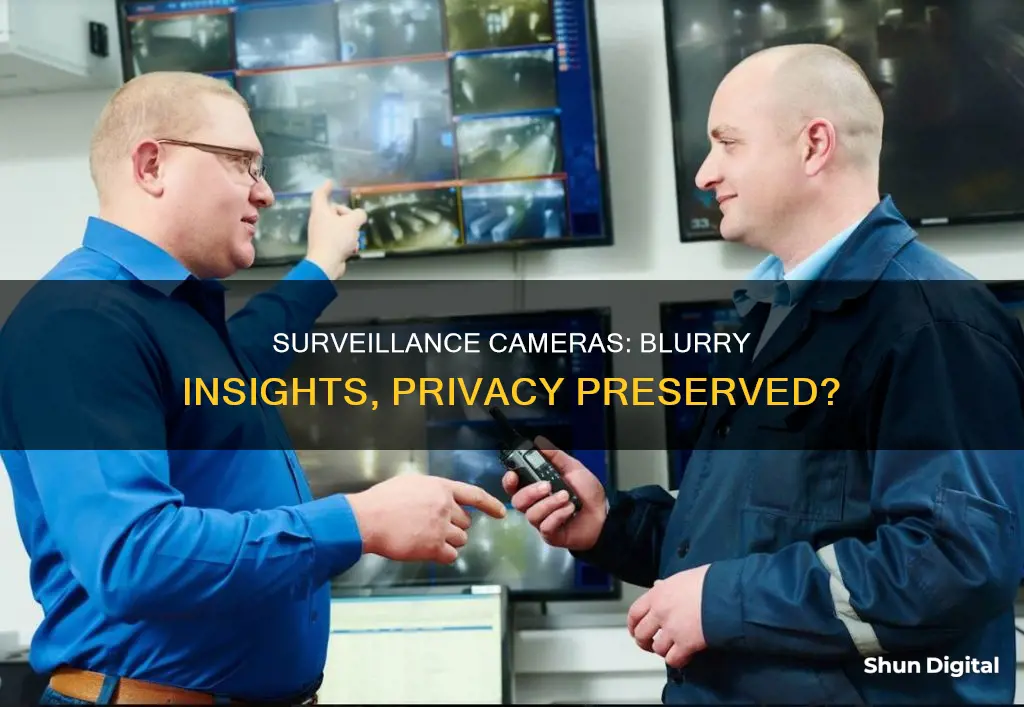
Despite the ubiquity of high-quality smartphone cameras, security camera footage remains notoriously poor. This is surprising, given the importance of such footage in police investigations. The poor quality of security camera footage can be attributed to a variety of factors, including file resolution and compression, cropping, storage space, camera placement, and budget constraints. While high-quality security cameras are available, they are often prohibitively expensive for many small businesses, and the large amount of data generated by higher-quality footage is challenging to store.
| Characteristics | Values |
|---|---|
| File resolution | Low |
| File compression | High |
| Recording method | Analogue |
| Cropping | Common |
| Camera placement | High and out of the way |
| Lighting | Low |
| Storage space | Limited |
What You'll Learn
- Storage space: HD footage takes up a lot of room, so lower resolutions are used to save costs
- File resolution and compression: The process of compressing files to save space results in lower quality
- Camera placement: Cameras are often placed high up, capturing hats and hoods instead of faces
- Lens quality: Cheaper cameras often have plastic lenses, which are lower quality
- Camera maintenance: Cameras placed outside are susceptible to damage and wear, which can reduce quality

Storage space: HD footage takes up a lot of room, so lower resolutions are used to save costs
The quality of security cameras is critical when choosing the right device to protect homes, businesses, or public spaces. However, storage space is a significant limiting factor for CCTV footage, and often, lower resolutions are used to save costs.
CCTV cameras are designed to be placed outdoors and must withstand various weather conditions. The footage from these cameras is typically stored for at least 24 hours and, in many cases, for weeks or months. The storage requirements for high-definition (HD) footage are immense, and the cost of storing large volumes of data can be prohibitive. As a result, lower-quality recordings are often chosen to reduce storage needs and save money.
The storage demand for security footage is enormous. Even a basic camera recording video for an entire day would take up approximately 1 terabyte (TB) of data. When scaled up to dozens or hundreds of cameras, as is the case for large companies or cities, the storage requirements become extremely challenging and expensive. For example, London, the most heavily observed city in the world, has approximately 500,000 CCTV cameras. The footage from over 15,000 cameras in the tube stations is kept for three days, while the train stations' recordings are retained for 28 days, necessitating vast storage capacity.
To manage the storage issue, compression techniques are applied to reduce file size and minimise the hard drive space needed. However, this compression results in a loss of visual quality and resolution. The lower the resolution, the less detail is captured, leading to blurry or distorted footage. Objects and people may appear pixelated or blocky, making identification challenging.
While technological advancements have improved camera capabilities, the requirements, expectations, and limitations of security systems differ from those of personal devices like smartphones. Security cameras are often used to capture low-light conditions or high-contrast situations, such as a person wearing dark clothes at night. While they excel in these scenarios, the trade-off is a lower-quality image that may be grainy or blurry, especially when the footage is cropped or zoomed in on for further examination.
Surveillance Cameras: Crime Reduction in Large Cities
You may want to see also

File resolution and compression: The process of compressing files to save space results in lower quality
The quality of surveillance camera footage is often compromised by the compression techniques used to reduce file size. Compression is necessary because video files are large, and storing them requires a lot of hard drive space. Even a basic camera recording video for a full day would take up approximately 1TB of data. With dozens or hundreds of cameras in operation, this quickly becomes a problem of scale.
Compression reduces the size of digital files through mathematical computations called algorithms. There are two types of video compression algorithms: frame-based compression and stream-based compression. Frame-based compression formats include JPEG, Wavelet, and JPEG 2000, while stream-based compression formats include MPEG-2, MPEG-4, H.264, and MPEG-7. Stream-based compression saves more storage space and network bandwidth but requires higher computing performance.
The most common compression formats used in surveillance cameras are JPEG2000, MPEG-4, and H.264. JPEG2000 offers better image quality at higher compression levels and allows for decompression to a lower-resolution representation of the image, which is useful for motion detection. MPEG-4 is more efficient than JPEG2000 in terms of compression ratio, but it is not suitable for systems with a frame rate below 5-6 frames per second. H.264 is the most efficient compression format, requiring much less storage space than MPEG-4 and JPEG, and it is ideal for systems with limited but stable bandwidth.
While compression helps reduce storage requirements, it comes at the cost of visual quality and resolution. This is a trade-off that needs to be considered when choosing a surveillance system, especially if the footage is intended for identification purposes.
Locking Camera Focus: A Guide to Mastering Sharp Photography
You may want to see also

Camera placement: Cameras are often placed high up, capturing hats and hoods instead of faces
Surveillance cameras are often placed high up on walls or ceilings to be less invasive and out of reach of vandals and thieves. However, this placement can result in the cameras capturing hats and hoods instead of faces, reducing their effectiveness in identifying individuals during theft or other security incidents.
In business and manufacturing settings, mounting cameras at a height of around 10 to 12 feet provides a broader view, supporting operational oversight over a wide area. In contrast, for facial recognition and capturing fine details, a height of about five to seven feet is recommended, as it aligns with the average human face level.
At entrances and exits, a combination of a higher camera (around seven feet) and a lower, eye-level camera can be effective. The higher camera provides an overview, while the lower camera captures facial details, ensuring a comprehensive record of all entrances and exits.
For license plate recognition, mounting cameras at a lower height of about three to four feet, angled upwards, is optimal. This setup ensures clear capture of license plates and avoids headlight glare at night.
While high camera placement can improve security by making cameras more difficult to tamper with, it can also reduce the effectiveness of the surveillance system in identifying individuals, as it may capture hats and hoods instead of faces. Therefore, a balanced approach is necessary, considering the specific needs and constraints of the location being monitored.
Leotax No. 13744: Unveiling the History of a Classic Camera
You may want to see also

Lens quality: Cheaper cameras often have plastic lenses, which are lower quality
Surveillance cameras are often of low quality due to a variety of factors, including the cost of the system, lens quality, storage space, and maintenance.
Cheaper surveillance systems tend to have plastic lenses and parts, which can result in lower image quality. The lens quality is an important factor in the overall performance of the camera. Plastic lenses are typically found in cheaper cameras and can be a significant contributor to poor image quality.
In addition to the lens quality, the storage space required for high-quality footage is also a consideration. Surveillance cameras are typically recording 24/7, and the amount of data generated is substantial. To reduce storage requirements, lower quality settings are often used, which results in blurry or pixelated footage.
Furthermore, the placement of surveillance cameras can also impact their effectiveness. Businesses often opt to place cameras in discreet locations, such as high on walls or ceilings, to avoid being invasive to customers. However, this can result in recordings that capture hoods or baseball caps instead of faces, making it difficult for law enforcement to identify suspects.
Overall, the quality of surveillance cameras is influenced by a combination of factors, including lens quality, storage limitations, and camera placement, among others.
Manual Mode for the S8 Plus Camera: Where is it?
You may want to see also

Camera maintenance: Cameras placed outside are susceptible to damage and wear, which can reduce quality
Surveillance cameras are often placed outside, where they are susceptible to damage and wear. This can lead to a reduction in image quality over time. To maintain the performance of outdoor security cameras, several measures can be taken:
Placement
Positioning cameras under eaves, overhangs, or in other sheltered areas can provide protection from various weather conditions. Additionally, mounting cameras slightly out of arm's reach can prevent theft and vandalism.
Weatherproofing
The selection of cameras with appropriate Ingress Protection (IP) ratings is crucial. An IP rating of 66, for instance, indicates that a camera is completely protected from dust and water jets. Weatherproof housings or additional covers can further safeguard cameras from rain, snow, and dust.
Temperature Control
In cold climates, built-in heaters can prevent frost and freezing issues, while fans are beneficial in hot or humid areas to regulate temperatures.
Sun Protection
Sun shields and hoods can protect lenses from direct sunlight, preventing issues like overheating, glare, and overexposure.
Insect Repellence
Insects are attracted to infrared lights used for night vision. Applying insect repellent around the camera, using insect sprays, or turning off IR LEDs can help keep insects away. Regular cleaning of the camera exterior is also essential to remove insect residue.
Corrosion Prevention
In coastal areas, the salt in the air can cause corrosion. Selecting cameras made of corrosion-resistant materials or applying anti-corrosion coatings can extend the lifespan of cameras in these environments.
Camera Maintenance
Regular maintenance is vital to ensure optimal performance and longevity. This includes cleaning the lens, checking for water intrusion, and inspecting for signs of wear and damage.
By implementing these measures, the quality of outdoor surveillance cameras can be maintained over time, reducing the chances of blurry or low-quality footage.
Choosing the Right Camera Profile for Your RAW Photos
You may want to see also
Frequently asked questions
Recording in high definition takes up a lot of storage space, which can be costly.
A mid-tier camera can record at ~1GB/minute, which would take up 1TB of storage for a week of footage.
Many businesses monitor live footage in full HD but store it at a lower resolution to save costs, compromising picture quality.
Yes, the placement of cameras can also reduce their effectiveness. Cameras placed high up or too far away may not capture useful footage, for example, capturing the top of a baseball cap rather than a person's face.
Yes, better quality surveillance footage would aid police investigations. Forensic video analyst Michael Plaxton states that "when I have good video, almost 80 per cent of the time it results in a plea".



